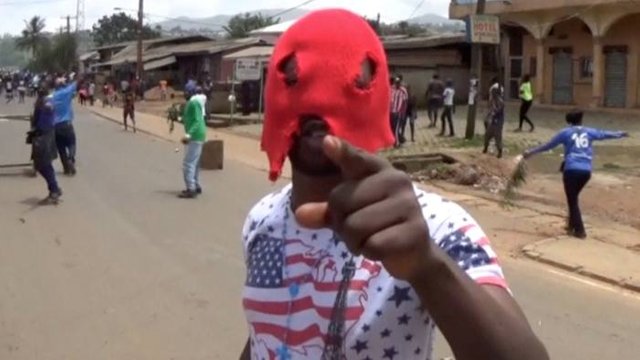When Wildlife and Warfare Mix: The Wildlife and Habitat of Anglophone Cameroon in Agony
Over the past six decades, more than two-thirds of the world’s remaining biodiversity hotspots have experienced civil war or armed conflict with many hotspots in Africa greatly affected. For example, during the 15-year bloody civil war that plagues Mozambique's from 1977 to 1992, Giraffe and Elephant herds in the Gorongosa national park decline by more than 90%. Also between 1983 and 1995, while the Lord's Resistance Army terrorized Uganda, two species of antelope, were wiped out completely in the country's Pian Upe reserve. Other countries whose wildlife has experienced a great decline include Rwanda, Democratic Republic of Congo and Kenya during the genocide that occurred in these countries. The effects have been countless, from destruction as a result of military schemes to indirect socioeconomic and political changes, human migration and displacement and decline in the wildlife population.

A masked independence protester in the English-speaking city of Bamenda, Cameroon © Reuters source
Today Anglophone Cameroon is also at the crossroad of losing a majority of its wildlife to the internally displaced person who now seeks refuge in nearby protected areas. Cameroon is among the countries in Africa where conservation and protection of the environment are internationally acknowledged. Due to its rich biodiversity, Cameroon has been described Cameroon as "Africa in miniature”. The rich wildlife consists of 8,260 recorded plant species including 156 endemic species, 409 species of mammals, 690 species of birds, 250 species of reptiles, and 200 species of amphibians. The habitats of these species include the tropical lowland forest, coastline mangroves forests, montane forests, and savannas. The Anglophone Cameroon (Southwest and Northwest regions of Cameroon) is endowed with these habitats, hosting important protected areas like the Korup National Park, Takamanda National Park, Mount Cameroon National Park, Tofala Hills Wildlife Sanctuary, Bakossi National Park, Bayang-Mbo Wildlife Sanctuary, Rumpi Hills Wildlife Sanctuary and the Kagwene Gorilla Sanctuary. These protected areas are home to endemic and threatened species such as the Critically Endangered Cross River Gorilla, Endangered Nigeria-Cameroon Chimpanzee, and Forest Elephants. These species and many more wildlife species of Anglophone Cameroon found in these protected areas is now faced with the on-going historic civil war baptized with the name "The Anglophone Crisis” plaguing this part of the country.
Presently in Anglophone Cameroon, many communities especially those close to protected areas now seeking refuge in the forest. As more and more people continue to move into the forests, markets have become deserted making it impossible for inhabitants to have access to sustainable sources of protein like beef, chicken, and pork. To remedy this situation the internally displaced people now hunt for food.
Apart from being hunted for food the wildlife are also sufferings from the reduction of space. Wildlife now fights their space with the internally displaced persons who now clear more lands to build new houses and open more farms. As this continues more and more wildlife are displaced from their home bring about population decline. With these ongoing devastating activities happening now the wildlife and habitats of Anglophone Cameroon are in great agony.
The same thing is actually happening in Abongphen Highland Forest (just 25 km away from the center of the independence movement - Bamenda city) as save place where they can hide and eventually settle. Since schools are more than one and the half year closed kids are helping their parents to clear more forest, to kill birds and to get other sources of food obviously without any worry about nature). The pressure on the natural environment is intensifying so it is more important than ever before to focus on forest conservation and providing local farmers alternative sources of livelihood which does not destroy the forest but instead protect it.
@manka
content creator
 | @kedjom-keku | Conservation Association |
| @treeplanter | Fund-raising upvoting bot | |
 | @forestfriendly | Water Saving bees |
REFERENCE
- Economist: How war affects wildlife
- Prinston University: The ecological costs of war in Africa
- Wikipedia: Wildlife of Cameroon
More opportunities how to help
Contribute to our transparent accounts
| EUR | IBAN: CZ8120100000002401262246 | BIC/SWIFT: FIOBCZPPXXX |
| USD | IBAN: CZ9020100000002801262245 | BIC/SWIFT: FIOBCZPPXXX** |
 |  | 1GVCsYsf2LzvyqDUYhXPjQbb2KtW6dDDH |
 |  | 8LsW14JHnbvpq6RefqASJMgySN6K8SgAiG |
 |
![]() Plant trees with our voting bot @treeplanter!
Plant trees with our voting bot @treeplanter!
 Check or website: www.kedjom-keku.com to get more information about our conservation program in Cameroon.
Check or website: www.kedjom-keku.com to get more information about our conservation program in Cameroon.